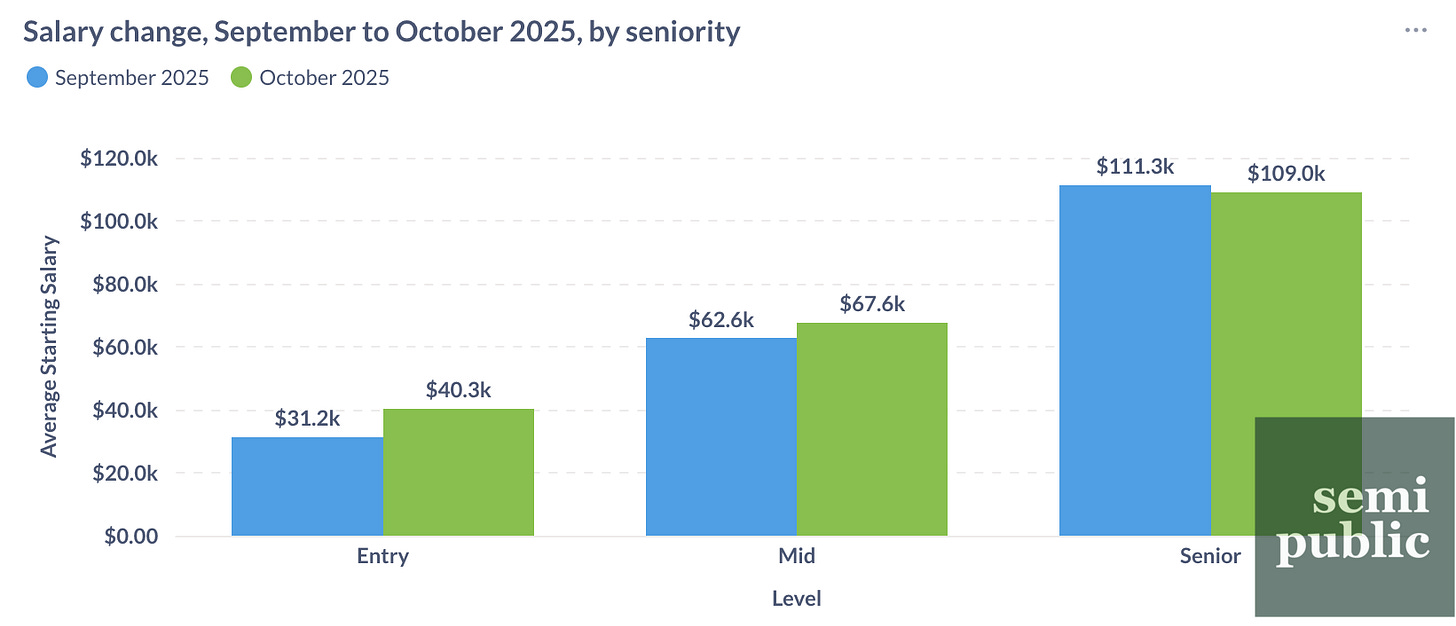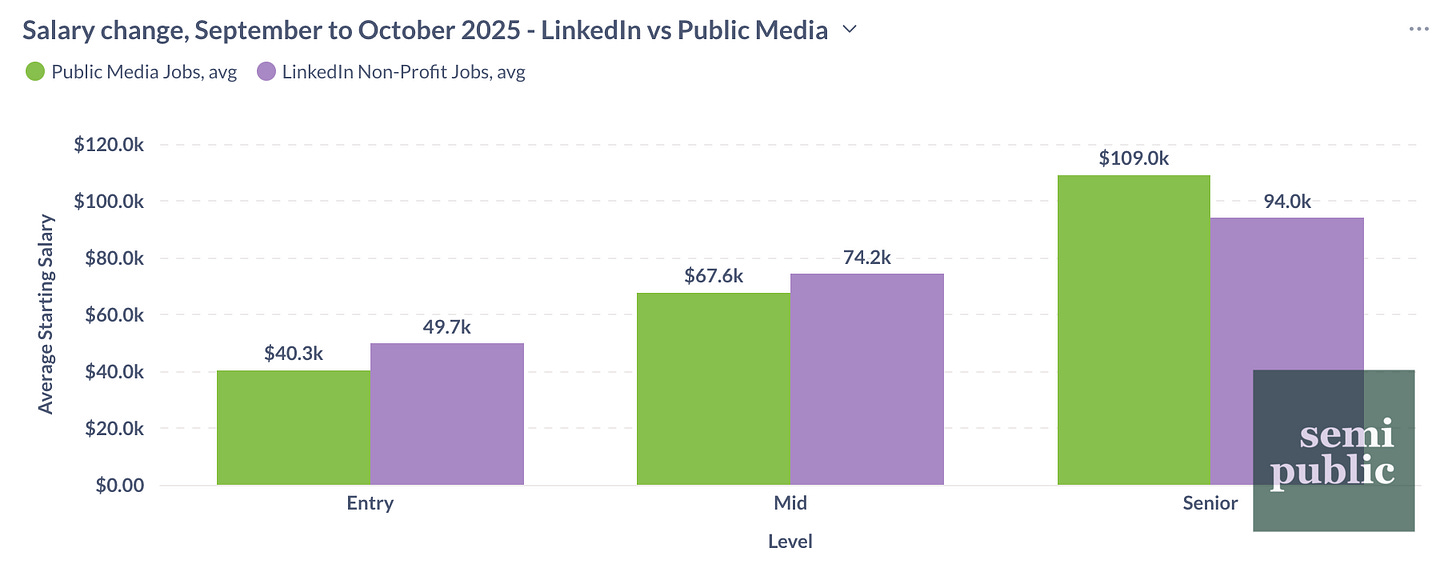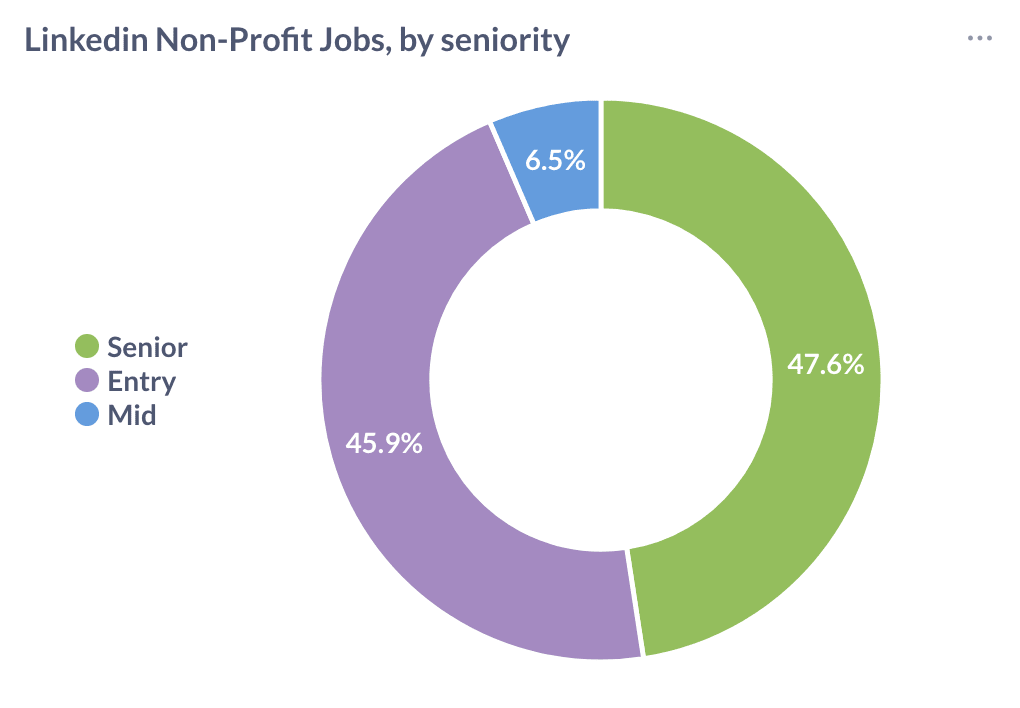Public Media Jobs Index: October 2025
A revamped index shows that total listings, as well as average starting salaries for entry to mid-level positions, rose compared to September
Last month, I published the very last Public Media Jobs Index using CPB Jobline data for September of 2025. I don’t have any regrets about focusing on the Jobline for my initial analyses (it was what I considered to be the de-facto industry jobs website), but I found myself increasingly dissatisfied. The industry is changing day-to-day, after all, I figured that I owed to it myself and anyone else who was interested in the index to create a more in-depth look at hiring trends.
So I did: Starting with the largest, I created scrapers for any job listings sites that exclusively featured public media jobs, including those from NPR, PBS, and APM. I am now monitoring daily job listings from over 15 websites (and counting).
Semipublic readers who have been around since last month also know that the process of creating over a dozen website scrapers presented a unique opportunity for me to launch something new: jobs.semipublic.co, a public media job listing aggregation website that, like Adopt A Station, sends job-seekers back to the original source of the listing in order to apply or learn more.
I also created a responsive Public Media Jobs Index inside the website, as sort of a test to see if minute-to-minute statistics on industry job listings would be useful. Turns out, they are (or I think so, anyway).
But back to the monthly, in-depth index: Not only is Semipublic tracking postings across multiple sites, we’ve also added new datapoints: Starting salary, location requirements, and similar stats from all non-profit job listings posted on LinkedIn since January 2024.
As you might expect, all of this new data show a complicated picture, where average starting salaries for early to mid-level job-seekers in public media have increased since September, but mostly lag behind other comparable non-profit jobs.
Earlier this year, I set out on a journey to collect every public media station’s financial documentation. I wanted to answer the question of what would happen when public media lost its federal funding.
Since launching Semipublic in April, my work has been featured nationally and has inspired other journalists to generate their own data-driven insights about public media. It even laid the groundwork for Adopt A Station, a website I built in 24 hours that pairs visitors with an at-risk public media station.
Altogether, the work to gather, analyze, and publish the industry’s essential data has taken me hundreds of hours. Now, I’m asking for your help: If you value Semipublic’s mission, or have ever benefited from insights published in this newsletter, take the time to become a paid subscriber for $8 a month. Or, you can buy me a coffee.
Total Listings Up, Average Salaries Down
The good news for the public media industry is that a survey of public media-specific job boards shows better hiring in October than in September. Not only that, but total unique listings, 134, outpaced the number of employees laid off, 96. Remember, CPB’s winding-down at the beginning of the month contributed around 70, while Prairie Public, WKU Public Media, and KCRW accounted for the other 26.
Additionally, starting salaries (the bottom of a given salary/hourly range, if applicable) for entry to mid-level career jobs increased by around 30% and 8%, respectively. According to the Bureau of Labor Statistics, the median weekly income in the U.S. was $1,196 - or $62k a year - in July, putting public media’s average starting salary for mid-level positions slightly above the average. Meanwhile, jobs website ZipRecruiter estimates the average entry-level salary to be around $32k. Public media’s was over $40k, a positive sign for public media newcomers.
(It has to be noted, though, that there are at least eight states in the U.S. in which $31.2k, the average salary for entry-level positions in public media in September of this year, would be at or below minimum wage.)
Something that I’ve been anxious to add to the monthly Public Media Jobs Index is a true comparison to the rest of the non-profit world. Included for the first time is a full dataset of all full-time or internship job listings on LinkedIn posted by non-profits in the month of October. Average starting salaries are calculated in the same way as public media’s: By taking the bottom of a given salary/hourly range, if provided.
When compared side-by-side, you can see that salaries for entry to mid-level public media job listings lag significantly behind their other non-profit counterparts, sometimes by over 20%. While the number of LinkedIn non-profit job listings is much larger than public media’s - over 20,000 versus 134 - the average salary in that dataset ($72.3k) was slightly lower than public media’s ($74.7k).
One trend I’ve been tracking over the past few months was the rise in number of senior-level job listings in public media. While that trend has abated slightly (as we’ll see in a moment), the industry’s highest-level job openings are offering starting salaries that are nearly 14% higher than comparable non-profit listings.
Interestingly, non-profit jobs in general are also showing a trend towards higher-than-average listings for senior-level positions. Where public media and the rest of the industry diverge, however, is with entry-level positions: Nearly half of all non-profit listings on LinkedIn in October were for entry-level positions, while they accounted for only a handful in public media. The good news is that, relative to last month’s index from CPB Jobline, the proportion of entry-level jobs has increased significantly.
Work to Do
With all of that in mind, here are the top lines from public media’s October hiring:
Salaries for entry to mid-level positions in public media increased, but still significantly lag behind comparable positions in other non-profits.
Meanwhile, salaries for senior-level public media positions remained much higher than their non-profit counterparts, even with a slight decrease in average from September to October.
Public media’s elevated senior-level hiring was reflected in hiring for other non-profits.
The percentage of career opportunities for employees just starting out in public media, however, significantly lags behind other non-profits.
It’s clear that the hurdle for newcomers to enter public media, while smaller than it was in September, is still alarmingly tall. And (despite my own assumptions), that hurdle doesn’t seem to be as insurmountable in other non-profit industries.
On the flip-side, movement in and out of senior-level public media positions seems to still be occurring, and with higher—than-average salaries to help incentivize leaders to stay.
We’ll see if these patterns continue as we enter the winter holiday season.
If you enjoyed this post, please consider supporting me with a paid subscription, or by buying me a coffee. And, as always, please leave a like. It’s very much appreciated.









